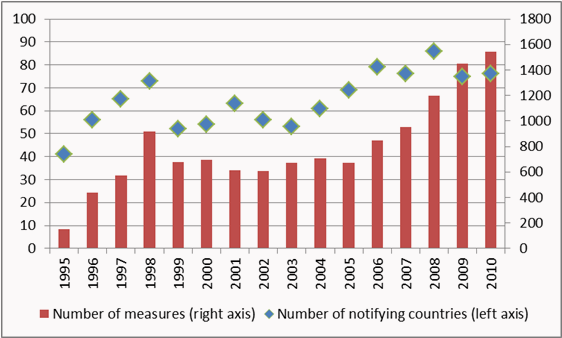Data limitations make it difficult to document general trends in the use of non-tariff measures. Nevertheless, WTO internal sources of information suggest that the incidence of ‘public policy’ measures – that is, technical barriers to trade (TBT) and sanitary and phytosanitary (SPS) measures – has been on the rise (on this and other protectionist measures see Evenett 2012).
First, the number of notified regulatory barriers has been increasing since the mid-1990s (see Figure 1). Second, over the same period, the number of specific trade concerns raised by WTO members in the Technical Barriers to Trade Committee has also been trending upwards.1 Evidence from disputes, however, is inconclusive.
Looking at the cross section, there is clear evidence of the predominance of regulatory measures over other non-tariff measures. This is reflected both in new data collected from official sources by the UN Conference on Trade and Development and in the evidence from business surveys conducted by the International Trade Centre. According to this latter source, about half of the non-tariff measures considered to be burdensome by firms in the 11 developing and least developed countries where surveys have been conducted, are TBT/SPS measures. Business surveys also show that, for exporters, more than 70% of burdensome non-tariff measures raise a procedural obstacle. Evidence from business surveys also reveals that TBT/SPS are a major concern for EU exporters, representing more than half (52%) of all problems they report. The equivalent share for US exporters is much lower, at 22%, although the two figures cannot be compared due to different methodologies.
Figure 1a: SPS notifications, 1995-2010 (number of notified measures and notifying countries per year)
Figure 1b: TBT notifications, 1995-2010 (number of notified measures and notifying countries per year)
Source: WTO I-TIP database
Why governments use non-tariff measures
Non-tariff measures, and in particular technical barriers to trade and sanitary and phytosanitary measures, are often the first-best instruments to achieve public policy objectives. They can be used to correct market failures arising from information asymmetries or imperfect competition, and to pursue non-economic objectives, such as the protection of public health. At the same time, however, non-tariff measures can also be used by political incumbents to protect domestic producers. A recent report by the WTO discusses how the fragmentation of supply chains and growing attention by consumers to quality and safety of food products have contributed to an increase in both governmental and private measures related to food safety and quality (WTO 2012). It also illustrates the intertwining of public policy goals and domestic producer interests in the context of climate change mitigation policies.
Trade and welfare effects of non-tariff measures
The trade and welfare effects of non-tariff measures do not necessarily carry the same sign. Non-tariff measures may reduce trade and yet increase welfare in the country that applies the measure. The effects depend on the nature of the market failure that the measure addresses, the type of non-tariff measure used and other market-specific circumstances. The trade and welfare effects of quality measures such as technical barriers to trade and sanitary and phytosanitary measures depend on whether they address genuine market failures. If a measure is applied only to protect domestic producers, both trade and welfare in the importing country decrease. If, however, the measure corrects a market failure, welfare is likely to increase with ambiguous effects on trade.
The trade literature uses ad valorem tariff equivalents to estimate the degree of restrictiveness of non-tariff measures. Existing empirical evidence suggests that non-tariff measures can significantly restrict trade. The ad valorem equivalent approach, however, presents conceptual and methodological limitations. In the presence of market uncertainty or when non-tariff measures take the form of fixed market entry costs, non-tariffs can have different effects to tariffs. Ad valorem equivalent estimates also fail to adequately capture the trade-restrictive effect of certain non-tariff measures in the presence of production sharing (Ferrantino 2012). Another weakness of ad valorem equivalents is that they only provide an estimate of the overall effect of non-tariff measures which cannot be decomposed by measure. In the case of the technical barriers to trade and sanitary and phytosanitary measures more specifically, empirical evidence confirms that these may either increase or decrease trade and that harmonisation and mutual recognition are ways in which any negative trade effects can be mitigated.
Reasons for regulating non-tariff measures
Economic theories of trade agreements emphasise policy substitution as the main rationale for international co-operation and regulation of non-tariff measures (Bagwell and Staiger 2002). In traditional theory, tariffs are seen as the first-best instrument to manipulate the terms-of-trade. Governments set non-tariff measures to address legitimate public policy concerns, and regulations on these measures only need to address ‘policy substitution’ between tariffs and non-tariffs. As for the commitment approach, it suggests that non-tariff measures should be regulated because if they remain unbound, tariff commitments would be undermined as policymakers could simply use them more intensively once tariff bindings have been negotiated.
Policy substitution, however, is not the only problem that the regulation of non-tariff measures in trade agreements attempts to address. The report identifies several additional concerns related to the nature of non-tariff measures that regulation may need to address.
- First, their opacity considerably complicates co-operation on non-tariff measures, for instance by making their enforcement more challenging.
- Second, contrary to tariffs, non-tariff measures increase fixed costs and therefore deter market entry. Governments may wish to cooperate to limit the strategic competitive effects of non-tariff measures.
- Third, private standards adopted by economic agents can serve as non-tariff measures and governments may wish to regulate them as they regulate non-tariff measures.
- Finally, the fragmentation of the production process across different countries creates new forms of cross-border policy spillovers. These new forms of policy spillovers may require direct co-operation on non-tariff measures.2
GATT/WTO disciplines on non-tariff measures
GATT rules on non-tariff measures are consistent with a shallow integration approach. They directly regulate tariffs and other border measures, but impose no discipline on domestic measures other than a non-discrimination obligation. They aim at ensuring that governments have the ability to use non-tariff measures to achieve legitimate public policy purposes, so long as they do not replace bound tariffs with non-tariff measures. The agreements on technical barriers to trade and sanitary and phytosanitary measures are ‘post discriminatory’ agreements. They include obligations, such as the need to ensure that requirements are not unnecessarily trade restrictive, that are additional to the non-discrimination obligation. They also encourage the use of international standards, which can be seen as a weak form of regulatory convergence.
Challenges to international co-operation on non-tariff measures
As already mentioned, the diffusion of global production networks and the growing use of non-tariff measures to address broad consumer and general interests such as food safety and environmental quality, raise governance challenges. Deep rather than shallow integration seems to be needed to solve the type of problems associated, for example, with the proliferation of global production chains. It is not clear how far existing ‘deep integration’ provisions in the agreements on technical barriers to trade and sanitary and phytosanitary measures and in preferential trade agreements can go in addressing these problems.
An examination of the tools used by WTO members to address non-tariff measures suggests that difficulties in finding the right balance between policy commitments and flexibility persist in the multilateral trading system. The report points to the tension between an economic framework that emphasises the potential benefits of a ‘non-violation’ provision, and the legal framework that relies on ‘clear infringement’ of a GATT provision. It also underlines the trade-offs implied by harmonisation and mutual recognition and the ambiguity of their trade effects.
Existing transparency provisions in the WTO agreements help address the problems raised by the opacity of non-tariff measures but they are not sufficient. This is, in part, because, contrary to what is often argued, not everyone benefits from transparency. The challenge is to improve the quantity, the quality and the accessibility of information collected through the various transparency mechanisms, both on measures and on problems associated with the measures. WTO notifications should play the key role in a new sustainable mechanism for transparency in non-tariff measures, which would also involve other institutions. To enhance the contribution of notifications, Members' compliance with the notification requirements and the quality of the information they provide need to be improved substantially. This will only be possible if the incentive problem can be addressed.
One of the main challenges facing the regulation of non-tariff measures is where to draw the line between protectionist and non-protectionist non-tariff measures. In the GATT, the approach used is to allow domestic regulatory measures provided that they do not discriminate against the imported product. One of the issues that has arisen in connection with national treatment concerns the relevance and weight to be given to the rationale or purpose of the measure. The report argues that economic theory can help identify situations in which governments may be more likely to use non-tariff measures to address competitiveness concerns rather than the stated public policy rationale. Indeed, an analysis of the efficiency and incidence of the measure in question, and of the wider sectoral and political context would help identify the purpose of non-tariff measures.
Convergence towards international standards, which is encouraged in the agreements on technical barriers to trade and sanitary and phytosanitary measures, creates tensions in practice. International standards may be difficult to use and preferences may vary among WTO members. Also, the capacity to influence international standard setting may differ among countries. Finally, the role of the WTO in addressing the trade impact of ‘private standards’ needs clarification. Capacity building in the area of standards has a vital role to play in improving international cooperation on technical barriers to trade and sanitary and phytosanitary measures.
The authors are staff members of the WTO secretariat. Any views are their own and not attributable to Members of the WTO or to the WTO Secretariat.
References
Bagwell, K. and Staiger, R. W. (2002), The Economics of the World Trading System, Cambridge, MA: MIT Press.
Evenett, Simon J (2012), “Débâcle: The 11th GTA report on protectionism”, VoxEU.org, 14 June.
Ferrantino, M. J. (2012), "Using Supply Chain Analysis to Analyze the Costs of NTMs and the Benefits of Trade Facilitation", Geneva, World Trade Organization, Working Paper ERSD 2012-02.
Staiger, R. W. (2012), "Non-tariff measures and the WTO", Geneva, World Trade Organization, Working Paper ERSD 2012-01.
World Trade Organization (2012). "Trade and public policies: a closer look at non-tariff measures in the 21st century", Geneva: WTO.
1 The number of new sanitary and phytosanitary concerns has fluctuated widely over the last 15 years and so has the number of resolved concerns, but the cumulative number of concerns has increased.
2 See Staiger (2012) for an excellent overview of the nascent literature on trade agreements under offshoring.




